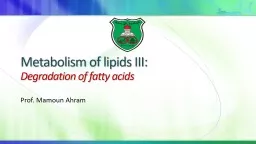

Degradation of fatty acids Prof Mamoun Ahram Resources This lecture Lippincotts Biochemistry Ch 16 Lipids and energy TAGs are the bodys major fuel storage reserve The complete oxidation of fatty acids to CO2 and H2O generates 9 kcalg fat as compared to 4 kcalg protein or carbo ID: 908254
Download Presentation The PPT/PDF document "Metabolism of lipids III" is the property of its rightful owner. Permission is granted to download and print the materials on this web site for personal, non-commercial use only, and to display it on your personal computer provided you do not modify the materials and that you retain all copyright notices contained in the materials. By downloading content from our website, you accept the terms of this agreement.
Slide1
Metabolism of lipids III:Degradation of fatty acids
Prof. Mamoun Ahram
Slide2Resources
This lecture
Lippincott’s Biochemistry, Ch. 16
Slide3Lipids and energy
TAGs are the body’s major fuel storage reserve.
The complete oxidation of fatty acids to CO2 and H2O generates 9 kcal/g fat (as compared to 4 kcal/g protein or carbohydrate. Why?
Slide4Hormonal regulation
Adipose triglyceride lipase
Hormone-
Sensitive lipase
Monoacylglycerol lipase
Note: Acetyl CoA carboxylase (ACC) is inhibited by the same signaling pathway
ATGL: Adipose triglyceride lipase
HSL: Hormone-sensitive lipase
MGL: Monoacylglycerol lipase
Glycogen phosphorylase
Slide5Perilipin
Perilipin coats fat droplets blocking HSL. It is phosphorylated by PKA releasing it.
G3P
X
ATGL: Adipose triglyceride lipase
HSL: Hormone-sensitive lipase
MGL: Monoacylglycerol lipase
Albumin
X
IR
Expression
Slide6Glyceroneogenesis
PC: Pyruvate carboxylase
PEPCK:
phosphoenolpyruvate
carboxykinase
thiazolidineiones
Glycerol leaves adipocytes to liver
Slide7Fatty acid β-
oxidation
Slide8LCFA is mitochondrial
Thiokinase
Acyl-CoA
Carnitine palmitoyl transferase I
+
Carnitine palmitoyl transferase II
C
arnitine shuttle
Exchange
Malonyl-CoA
X
Slide9More on carnitine…sources
X
Do not memorize the pathway
contains ~97% of all carnitine in the body.
contains ACC2 that is inhibited by acetyl CoA.
Slide10Carnitine deficiencies
Primary carnitine deficiency
Defects in a membrane transporter: No uptake of carnitine by cardiac and skeletal muscle and the kidneys, causing carnitine to be excreted.
Treatment: carnitine supplementation.
Secondary carnitine deficiency
Taking valproic acid (antiseizure)
decreased renal reabsorption
Defective fatty acid oxidation
acyl-carnitines accumulate
urineLiver diseases decreased carnitine synthesisCPT-I deficiency: affects the liver; no use of LCFA, no energy for glucose synthesis during a fast severe hypoglycemia, coma, and deathCPT-II deficiency: affects the liver, cardiac muscle, and, less severely, skeletal muscle
Treatment: avoidance of fasting and adopting a diet high in carbohydrates and low in fat but supplemented with medium-chain TAG.
Slide11SCFAs and MCFAs
Note: No regulation of entry like that of CPTI by malonyl CoA
Slide12β-Oxidation of fatty acids
Number of cycles: (n-2)-1
Oxidation
Hydration
Oxidation
Thiolytic cleavage
A
cetyl CoA/CoA
X
Slide13Induction of gluconeogenesis and fates of acetyl CoA
Slide14Synthesis vs. degradation
Slide15MCAD deficiency
There are 4 isozymes of fatty acyl CoA dehydrogenase for SCFA, MCFA, LCFA, and VLCFA
Medium-chain fatty acyl CoA dehydrogenase (MCAD) deficiency,
An autosomal-recessive disorder
Most common inborn error of β-oxidation (1:14,000 births worldwide
Higher incidence in Caucasians of Northern European descent
Decreased ability to oxidize MCFAs (lack of energy)Severe hypoglycemia and hypoketonemia
Treatment: avoidance of fasting
Slide16Oxidation of odd-numbered FAs
Metabolic acidosis and neurologic manifestations
If deficient,
If not activated,
N
ote: Loss of electrons
Slide17Monounsaturated fatty acid β-oxidation
But this reaction is skipped resulting in less FADH2
loss of electrons
Slide18Polyunsaturated fatty acid β-oxidation
Oxidation of a double bond at an even-numbered carbon, such as 18:2(9,12) (linoleic acid), requires an
NADPH-dependent 2,4-dienoyl CoA reductase
in addition to the
isomerase.
Note: loss of electrons
Slide19Peroxisomal β-oxidation
Catalase
VLCFA ≥22
Zellweger syndrome: a peroxisomal biogenesis disorder
X-linked adrenoleukodystrophy: dysfunctional transport VLCFA across the peroxisomal membrane
Accumulation of VLCFAs
Slide20Peroxisomal α-oxidation
Slide21Peroxisomal α-oxidation
Phytanic acid is a breakdown product of Chlorophyl.
It is activated by CoA, transported into peroxisome, hydroxylated by phytanoyl CoA α-hydroxylase (
PhyH
), and carbon 1 is released as CO2.
When fully degraded, it generates formyl-CoA, propionyl-CoA, acetyl-CoA, and 2-methyl-propionyl-CoA from the methyl-end.
Refsum
disease is an autosomal-recessive disorder caused by a deficiency of peroxisomal
PhyH
.
Slide22ω-Oxidation
ω-
Oxidation is a minor pathway of the SER
It generates dicarboxylic acids.
It is upregulated in certain conditions such as MCAD deficiency.